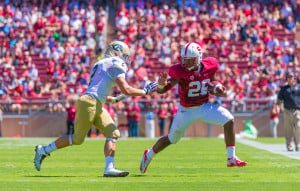5: As if the 55-21 “What’s Your Deal” game in 2009 could have any more intrigue, consider that the average margin of victory for the winning team in this rivalry since that beat-down in the Coliseum sits at five points with Stanford owning a 3-1 record in that span. Stanford always seems to take USC’s best shot and vice versa. Saturday looks to be no different.
57.7 percent: In 2013, the Cardinal offense scored on a touchdown on just 30 out of 52 trips to the red zone, or 57.7 percent of the time, the team’s lowest conversion rate in the past six years. Against USC, Stanford’s red zone issues were magnified as the Card scored one touchdown on four trips inside the 20 and came away with no points on two other occasions.
Head coach David Shaw received a great deal of criticism for his red zone play-calling against the Trojans, particularly on a now-notorious Wildcat formation. While they may not match the otherworldly touchdown conversion rate of 76.8 percent put up by the 2011 Cardinal led by Andrew Luck and the Tree Amigos of Coby Fleener, Zach Ertz and Levine Toilolo, a more seasoned Kevin Hogan and fresh crop of tight ends might help Stanford turn things around in 2014.

One major benefit Stanford will have this time around is playing at home. Last season, the Cardinal put up a respectable touchdown conversion rate of 65.5 percent in Stanford Stadium, but only managed to cross the goal-line on 47.8 percent of trips to the red zone. There’s nothing quite like home cooking (and the absence of 93,000 people screaming in your ear).
701: The amount of total yards USC put up on Fresno State in Week 1. Regardless of the opponent — and Fresno State should not be overlooked — putting up 700 yards of total offense is pretty darn impressive. New Trojan head coach Steve Sarkisian has departed from the pro-style offense of predecessor Lane Kiffin and installed a wide-open spread attack. With a rich amount of athletic explosive receivers, headlined by wide receiver Nelson Agholor, Sarkisian’s new offense seems to fit very well with his personnel. On Saturday, look for the Cardinal to get a lot of mileage out of their nickelbacks, senior Ronnie Harris and junior Zach Hoffpauir, as USC will look to spread things out.
6.8: In 2013, the USC defense allowed 6.8 rushing first downs per a game, good for 13th in the nation. Behind a monstrous front line led by NFL prospect Leonard Williams, the Trojans’ rush defense was one of the best in the country, especially on late downs. In last year’s matchup, Stanford only managed to convert on 4-of-12 third downs, with only two of those first downs coming on the ground.
Running back Tyler Gaffney actually had a lot of success against the Trojans, gaining 158 yards on 24 carries, but most of Gaffney’s yards came after contact. New starter Kelsey Young and backups Barry Sanders, Remound Wright and Ricky Seale all weigh at least 25 pounds less than Gaffney and may not be able to bruise their way through an aggressive Southern California front. If the power running game isn’t working, Shaw might look to generate some runs on the outside. If Shaw decided to get creative, we might also get a good look at how freshman running back Christian McCaffrey will fit into this offense.
+143 vs. -24: The Trojans tended to start fast in 2013 before cooling down and the Stanford game was no exception. Overall, the Trojans outscored opponents by a combined 143 points in the first half of games, but were outscored themselves by a combined 24 points in the second half. On his team’s first possession of the game, USC quarterback Cody Kessler looked composed beyond his years as he led his team on a nine-play, 63-yard touchdown drive. While often inconsistent, Kessler looks like one of the best quarterbacks in the conference when he feels comfortable. On Saturday, it will be up to the Stanford defense to get Kessler out of his comfort zone from the start and prevent the Trojans from jumping out to their customary early leads.
Contact Vihan Lakshman at vihan ‘at’ stanford.edu.
